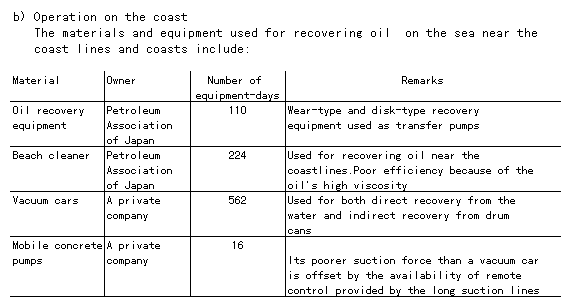b) Operation on the coast
The materials and equipment used for recovering oil on the sea near the coasts include:

FASTANK and drum cans were used as recipients for recovered oil.
The total amount of oil/water mixtures recovered using these items of recovery equipment is about 6,600 kL. To this number should be added the amount of the oil recovered by many volunteers' manual operations; the total amount of oil/water mixtures recovered and delivered to appropriate reception facilities is accordingly about 47,000 kL.
c) Preparation of provisional storage pit for oil recovered
As the amount of oil drifting and washed ashore increased, it was anticipated that the amount of oil recovered also would increase to the extent that temporary storage in drum cans could not keep up with such an increase. Therefore, provisional storage pits were installed in the Fukui, Tsuruga and Suzu areas where the amount of oil/water mixture recovered has already proved to be relatively large.
5. Conclusion
(1) Decontaminating capability in areas of the Japan Sea
In winter, it is practically impossible to perform maritime operations due to strong winds in the Japan Sea. For this reason, most of the work boats based on the Japan Sea side are moved to the Pacific side, and there remain a limited number of such boats available for emergency use.
The number of vessels calling at ports on the Japan Sea side is smaller than on the Pacific side and the number of large vessels and tankers navigating under unfavourable sea and weather conditions is also smaller.
Thus, there are few work boats immediately available for decontamination for oil spills in areas on the Japan Sea side in winter. The overall decontaminating capability on the sea is extremely limited on the Japan Sea, compared to that on the Pacific side.
(2) Materials and equipment available for oil recovery in open seas
In Japan, most of the materials and the equipment available for oil recovery operations are located in waters accessed by tankers, which are characterized by heavy shipping traffic, such as Tokyo Bay, Ise Bay, Osaka Bay, Seto Inland Sea and in enclosed and calm areas of petrochemical complexes that have a port. Hence, these materials and equipment are designed for use under smooth sea and weather conditions.
In the case of the NAKHODKA, all of the vessels except for the oil recovery vessels actually mobilized are designed for use in harbours and are not serviceable under stringent conditions in open seas.
(3) Private decontamination organizations
Decontamination organizations include governmental (national and local) competent and obligatory